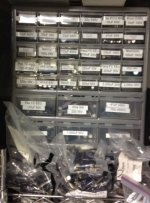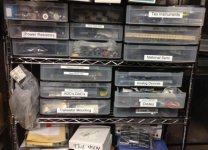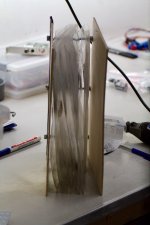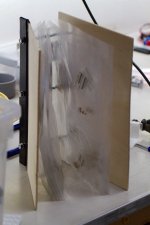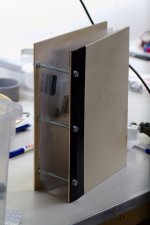All,
This is my question: How do you store your Resistors and small Capacitors?
This is my (and your?) problem: I do own many parts, most small, that need to be stored. Using compartmented small boxes is not ideal (for instance 2 decades of e192 resistors is about a 1000 compartments).
What to do? So I thought I ask my fellow resistor addicts
Regards,
Frans.
This is my question: How do you store your Resistors and small Capacitors?
This is my (and your?) problem: I do own many parts, most small, that need to be stored. Using compartmented small boxes is not ideal (for instance 2 decades of e192 resistors is about a 1000 compartments).
What to do? So I thought I ask my fellow resistor addicts
Regards,
Frans.
How do you store your Resistors and small Capacitors? This is my (and your?) problem: I do own many parts, most small, that need to be stored.
Using compartmented small boxes is not ideal (for instance 2 decades of e192 resistors is about a 1000 compartments).
I'd suggest very small plastic reclosable bags with a paper ID label enclosed. Having loose parts in bins allows parts to migrate.
You can group the bags by decade of value and bin them. 1 1/2 x 2" 2 Mil Reclosable Bags S-220 - Uline
How about envelopes, in a map, Wim(P) ?
Not my idea, Mr Wurcer or Mr Martin's I think.
(for 100-up a value, I still use compartment boxes, with added diy divisions. With >20k resistors of various brands not much choice. Some are kept in round plastic containers, HEMA/Xenos. Empty perfume bottles in the right shape, hotel shampoo ones are a favorite, also an avid film roll box collector)
Not my idea, Mr Wurcer or Mr Martin's I think.
(for 100-up a value, I still use compartment boxes, with added diy divisions. With >20k resistors of various brands not much choice. Some are kept in round plastic containers, HEMA/Xenos. Empty perfume bottles in the right shape, hotel shampoo ones are a favorite, also an avid film roll box collector)
I'd suggest very small plastic reclosable bags with a paper ID label enclosed. Having loose parts in bins allows parts to migrate.
You can group the bags by decade of value and bin them. 1 1/2 x 2" 2 Mil Reclosable Bags S-220 - Uline
The (my) problem with these is break-down's, they tend to be real bad quality some of these bags break down (the zip mechanism) after only 2 or 3 times usage. Also they sag and this makes a mess of the box where they are stored. maybe small boxes will do. Any way I will see if I can get good sturdy bags to be used.
I purchase the Vishay CMF-55 and CMF-60 resistors by the box, just label the end of the box. Other components are in polyethylene compartmented cabinets which are very inexpensive at Home Depot, or Bed n Bath stores.
Attachments
How about envelopes, in a map, Wim(P) ?
Not my idea, Mr Wurcer or Mr Martin's I think.
(for 100-up a value, I still use compartment boxes, with added diy divisions. With >20k resistors of various brands not much choice. Some are kept in round plastic containers, HEMA/Xenos. Empty perfume bottles in the right shape, hotel shampoo ones are a favorite, also an avid film roll box collector)
Paper envelopes, that's what we used in the old day's (ice ages) the problem is, they deteriorate very fast, you can not see what is in them (there may be different sizes (wattages) in each). For E12 (and I have a lot of those) the compartmented drawers are fine, but this is not possible for E96 and E192 (as I am using mostly nowadays).
Most of the resistors that I use are CMF55 or RN55 and 60's like you do. But most are delivered in non reclose-able bags, some in boxes, come bags are transparent and others not. I would like a more organized, and uniform, easily accessible storage system.
One problem (I see ) is that one only owns a small part of the range. At the moment that you get a new value you want to insert it at it's proper place, the envelopes/bags do support this. Coming to the conclusion that I want small transparent close-able boxes for the price of plastic bags.
) is that one only owns a small part of the range. At the moment that you get a new value you want to insert it at it's proper place, the envelopes/bags do support this. Coming to the conclusion that I want small transparent close-able boxes for the price of plastic bags.
One problem (I see
I purchase the Vishay CMF-55 and CMF-60 resistors by the box, just label the end of the box. Other components are in polyethylene compartmented cabinets which are very inexpensive at Home Depot, or Bed n Bath stores.
Further to Jacco's idea -- there are polyethylene sleeves in which photo-transparencies are stored. These fit in a 3-ring binder. I use the 2 1/4 x 2 1/4 (6x6cm) left over from my Rollei days for storage of precision resistors.
Yes, but the access ability is so-so, you can not 'insert' new values and they break easily. I do that for my ceramic capacitors and I do not like it
Further to Jacco's idea -- there are polyethylene sleeves in which photo-transparencies are stored. These fit in a 3-ring binder. I use the 2 1/4 x 2 1/4 (6x6cm) left over from my Rollei days for storage of precision resistors.
Self made capacitor 'album'
Attachments
I recycled clear plastic packaging, the kind people cuss trying to get open. Cut into rectangles slightly smaller than the bag, it makes a thin but sturdy structure, and can double as a divider so you don't have to have a new bag for those eg half-dozen 2-ohm flameproof resistors you overbought for a past project.The (my) problem with these is break-down's, they tend to be real bad quality some of these bags break down (the zip mechanism) after only 2 or 3 times usage. Also they sag and this makes a mess of the box where they are stored. maybe small boxes will do. Any way I will see if I can get good sturdy bags to be used.
I recycled clear plastic packaging, the kind people cuss trying to get open. Cut into rectangles slightly smaller than the bag, it makes a thin but sturdy structure, and can double as a divider so you don't have to have a new bag for those eg half-dozen 2-ohm flameproof resistors you overbought for a past project.
I like that, plastic bags with an 'sturdier' inside
Paper envelopes, that's what we used in the old day's (ice ages) the problem is, they deteriorate very fast, you can not see what is in them (there may be different sizes (wattages) in each). For E12 (and I have a lot of those) the compartmented drawers are fine, but this is not possible for E96 and E192 (as I am using mostly nowadays).
Some 'Ice age' pictures can be found here
https://www.flickr.com/search/?w=17267211@N05&q=stuut
(ice ages)
Envelopes can be bought in sturdy plastic nowadays, you know.
From art portfolio size, to teeny-weeny tiny.
Envelopes can be bought in sturdy plastic nowadays, you know.
From art portfolio size, to teeny-weeny tiny.
Ahhh, my mind was with those never used 'blauwe belastings dienst' (tax offices standard envelop). I'll check it out skipper
Cool pics indeed.... looks like alice in wonderland.
Self made capacitor 'album'
Hehe I also have cap albums, resistor albums, semis albums..... Everything that I have matched is in those albums.
I have an excel database with parts so I do not need to buy new everytime...
I keep unmatched parts in plastic bags....
Some folks use small vials and storage racks commonly used in molecular biology/biochemistry for freezing bacterial strains or cell lines. These vials are appropriate for SMD parts.
Here is a link to a group buy on a German site containing also a couple a pictures:
Sammelbestellung SMD-Sortimentskästen (Biozym Probenröhrchen) - Mikrocontroller.net
Here is a link to a group buy on a German site containing also a couple a pictures:
Sammelbestellung SMD-Sortimentskästen (Biozym Probenröhrchen) - Mikrocontroller.net
Cool pics indeed.... looks like alice in wonderland.
In the 70s/80s I did work there for about 5 years, best time in my life, not so great money wise, but work-fun and work-satisfaction... nothing better in this world. In December 2011 they closed, that last day I was invited to return to my old post and perform one last time
- Home
- Design & Build
- Parts
- How do you store your Resistors and small Capacitors?

